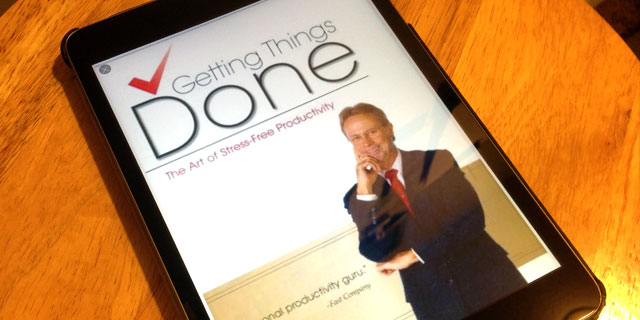
Do you ever feel like there just isn’t enough time in the day to accomplish all that you want? Of course, we all feel that way. However, we can become better at working on the right things, to get way more done than we did before. Productivity guru David Allen shares in Getting Things Done a method for getting your to-do list out of your head and into an actionable system.
Even though I read this book several years ago, I have re-read it twice just to keep the methods fresh in my head, as well as a good reminder of what can happen when I start to get sloppy with my to-do lists. A key point that Allen makes is not to think of “to-do” lists, but of “next-action” lists. This keeps our lists from growing out of control, and we always know what to work on next.
I have written down some of the key takeaways into a slideshow format for later review, as well as providing a downloadable PDF:
You can also download the PDF version of my notes on Getting Things Done here:
Getting Things Done Slides (PDF).
Slide Content:
- With the societal shift to knowledge work, new behaviors and tools are required to successfully manage workflow.
- Too much “stuff” stored in a person’s short- term memory can blow a fuse
- The conscious mind is a focusing tool, not a storage place.
- One must write down the outcomes they wish to achieve
- For every outcome, one must determine the “next physical action” required to move the situation forward
- This next physical action must be organized in a system one reviews regularly
- There are five stages of mastering workflow: to collect, process, organize, review and do.
- Collection tools include the physical in- basket, paper-based and electronic note- taking devices, voice-recording devices and email.
- Every open loop must be in your collection system and out of your head.
- You must have as few collection buckets as you can get by with.
- You must empty them regularly.
- If an item is not actionable, trash it, put it into a tickler file, or a reference file.
- If an item is actionable, what is the next action? If it takes less than 2 minutes, do it. If more, delegate or defer it.
- Project Planning Steps:
- #1 – Define the purpose and principles
- #2 – Envision the outcome
- #3 – Brainstorm how to get from here to there
- #4 – Organize sequences and priorities
- #5 – Identify the next actions
- To get started, take several hours or days to dump all of your projects and actions from running around in your head, living on post- it notes, etc.
- Get your inbox to empty by acting, delegating, or deferring.
- Never put anything back into “in.”
- To keep the system working, it is key that one continues to trust the system.
- Review the daily calendar and tickler folders.
- Take time each week for a weekly review.
- The Six-Level Model for Reviewing Your Own Work is presented in terms of altitude:
- 50,000 + feet: Life
- 40,000 feet: Three- to five-year visions
- 30,000 feet: One-to two-year goals
- 20,000 feet: Areas of responsibility
- 10,000 feet: Current projects
- Runway: Current actions
- One should use the mind to think about things, rather than of things.
- Before the end of a meeting, one should ask, “So what’s the next action here?” to increase clarity
- Even the slightest increase in the use of natural planning can bring significant improvement.